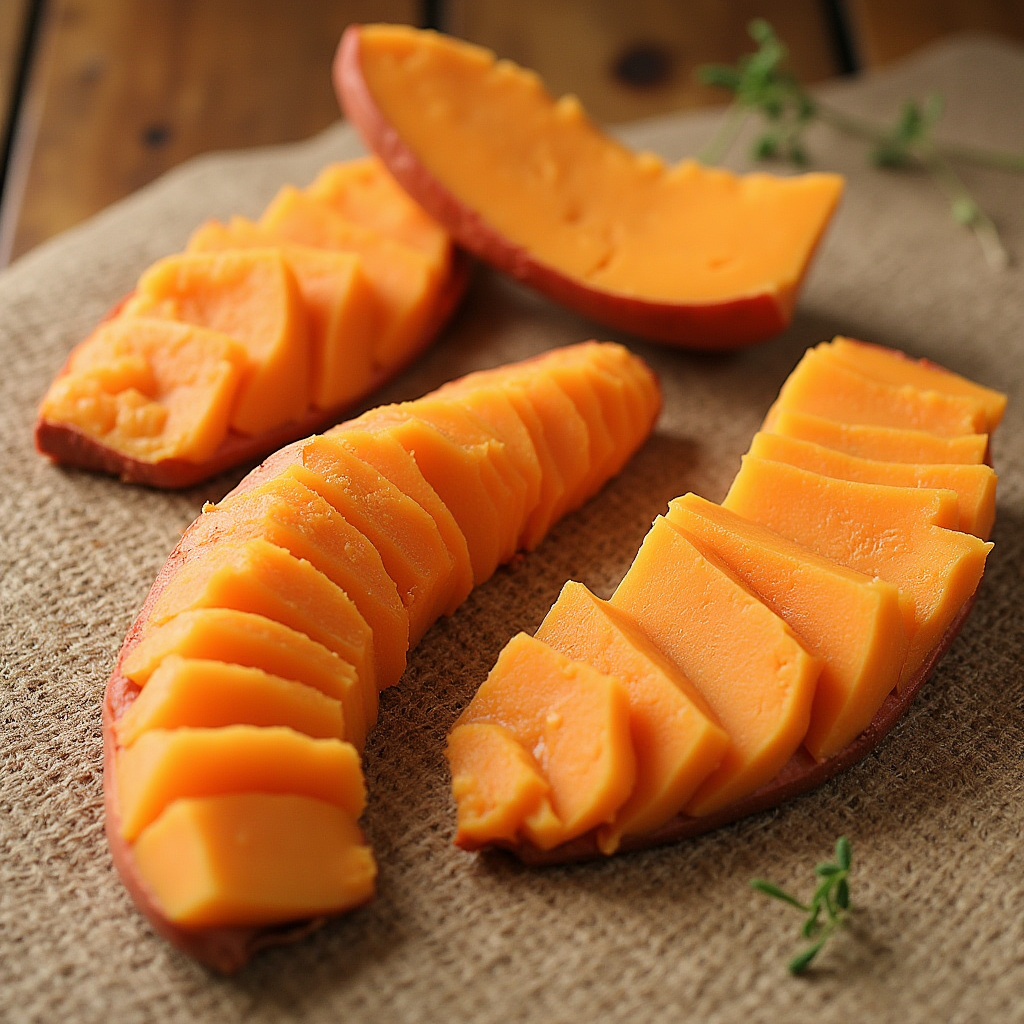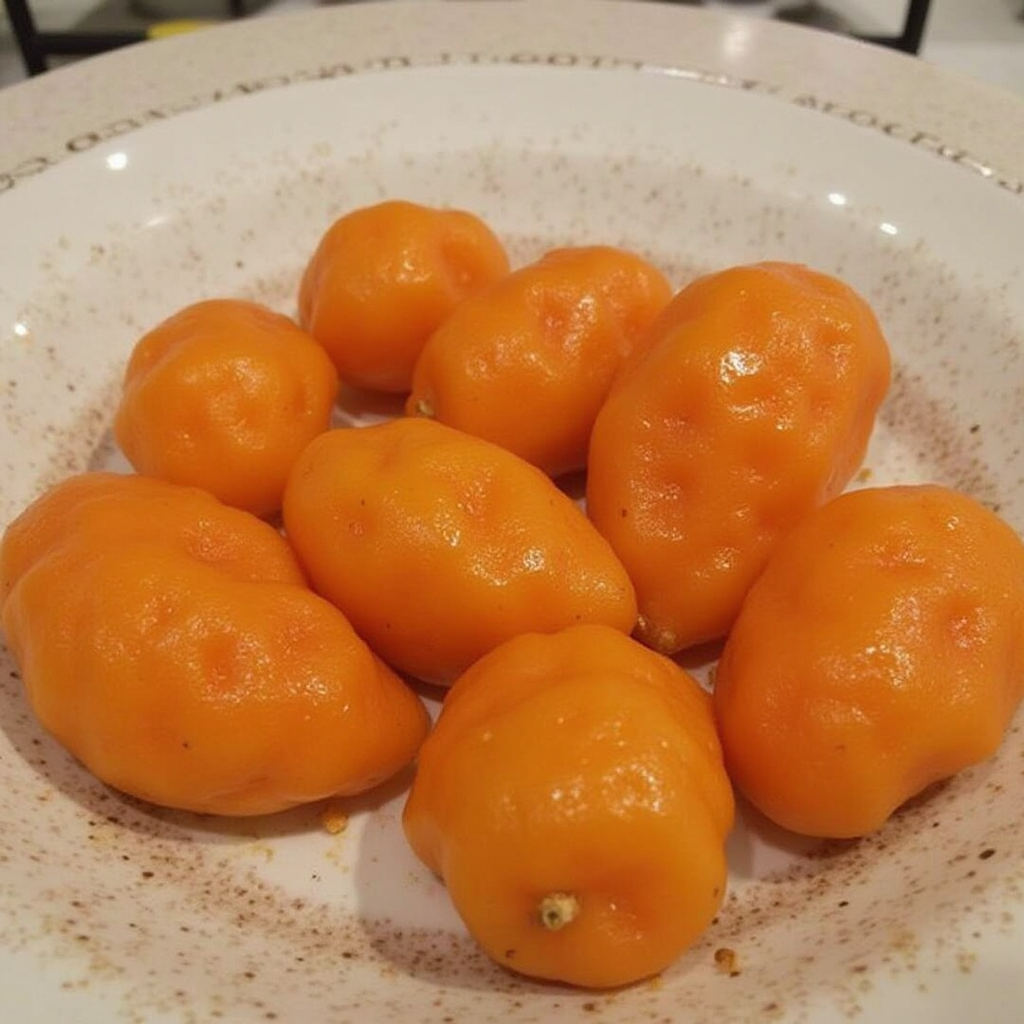Murasaki Sweet Potatoes first caught my eye at a local farmers’ market—not because I was searching for a new ingredient, but because of their striking deep-purple skin piled high in a rustic wooden crate. I was used to the vibrant orange sweet potatoes in my kitchen, but something about these rich, jewel-toned tubers made me stop and take notice. One curious conversation with the vendor later, I found myself heading home with a bag full of Murasakis and a mind buzzing with recipe ideas.
The first dish I made was a simple roast—just olive oil, sea salt, and a hot oven. The result was unforgettable. Creamy white flesh with a subtle nuttiness and an earthy sweetness that felt both familiar and entirely new. Since that day, Murasaki sweet potatoes have earned a permanent spot in my pantry. They’re my go-to for everything from weeknight sides to holiday showstoppers.
In this guide, I’ll take you on a flavorful journey through everything you need to know about Murasaki sweet potatoes: where they come from, why they’re nutritionally impressive, and how to make the most of their unique flavor in your kitchen. Whether you’re roasting, mashing, stuffing, or baking them into something sweet, these purple-skinned beauties are bound to become one of your favorite ingredients too.
Table of Contents
Table of Contents

Murasaki Sweet Potatoes
Description
Murasaki Sweet Potatoes first caught my eye at a local farmers’ market—not because I was searching for a new ingredient, but because of their striking deep-purple skin piled high in a rustic wooden crate. I was used to the vibrant orange sweet potatoes in my kitchen, but something about these rich, jewel-toned tubers made me stop and take notice. One curious conversation with the vendor later, I found myself heading home with a bag full of Murasakis and a mind buzzing with recipe ideas.
Ingredients
Potatoes
Instructions
Here are detailed instructions for preparing sweet potatoes using different cooking methods:
Roasting:
-
- Preheat your oven to 400°F.
-
- Slice the potatoes into wedges or cubes.
-
- Toss with olive oil, salt, and your favorite spices.
-
- Spread evenly on a baking sheet and roast for 25-30 minutes, flipping halfway through.
Baking:
-
- Pierce each potato several times with a fork.
-
- Place on a baking sheet and bake at 375°F for 45-50 minutes.
-
- Serve with butter, cinnamon, or savory toppings.
Steaming:
-
- Place the potatoes in a steamer basket over boiling water.
-
- Cover and steam for 20-25 minutes until tender.
-
- Use as a side dish or mash with spices.
Frying:
-
- Slice the potatoes into fries or rounds.
-
- Heat oil in a pan and fry until golden brown.
-
- Sprinkle with sea salt or seasoning
- Category: Veggies
- Method: Bake
- Cuisine: American
Origin and History of Murasaki Sweet Potatoes
Murasaki sweet potatoes were developed in Louisiana in 2001 by agricultural scientists looking to create a pest-resistant and disease-tolerant variety. This development was part of a broader effort to diversify the types of sweet potatoes available to consumers and to provide options that are both flavorful and resilient.
Despite their Japanese-inspired name—Murasaki translates to “purple” in Japanese—these potatoes are primarily grown in the United States. The name was chosen to reflect their vibrant purple skin, which is a distinguishing feature among sweet potato varieties. However, unlike the Okinawan purple sweet potato, which has purple flesh, Murasaki sweet potatoes have creamy white flesh, setting them apart in both appearance and texture.
The creation of Murasaki sweet potatoes was a response to the need for a variety that could withstand common pests and diseases while still offering a delicious and nutritious option for consumers. Their introduction has been well-received, and they are now a staple in many kitchens across the country.
Murasaki sweet potatoes are particularly popular in the southern United States, where they are grown extensively. Their nutty, less sugary taste appeals to a wide range of palates, making them a versatile ingredient in both traditional and modern recipes. Their growing popularity can be attributed to their ability to complement a variety of cuisines, from American comfort food to Asian-inspired dishes.
Physical Characteristics of Murasaki Sweet Potatoes
Murasaki sweet potatoes are visually striking, with features that set them apart from other sweet potato varieties. Their unique appearance and texture make them a favorite for culinary presentations and hearty meals.
Skin
The most noticeable feature of Murasaki sweet potatoes is their deep purple skin. This vibrant hue adds a pop of color to any dish, making them a popular choice for chefs looking to create visually appealing meals. The purple skin is not just for show—it’s also packed with antioxidants, which contribute to the potato’s health benefits.
Flesh
Unlike other purple sweet potato varieties, such as the Okinawan sweet potato, Murasaki sweet potatoes have creamy white flesh. This flesh has a firm, starchy texture that holds up well during cooking, making it ideal for a variety of culinary applications. When cooked, the flesh becomes soft and creamy, providing a neutral yet flavorful base that pairs well with both sweet and savory ingredients.
Size and Shape
Murasaki sweet potatoes are typically medium-sized, elongated, and uniform in shape. This consistency makes them easy to work with in the kitchen, whether you’re slicing them for fries, cubing them for roasting, or mashing them for a creamy side dish.
Comparison to Other Varieties
While Murasaki sweet potatoes share some similarities with other sweet potato varieties, they have distinct differences that set them apart. For example, the Okinawan purple sweet potato has purple flesh, while Murasaki sweet potatoes have white flesh. Additionally, Murasaki sweet potatoes have a nuttier, less sugary flavor compared to the traditional orange-fleshed sweet potato, making them a unique option for those looking to try something different.
Flavor Profile of Murasaki Sweet Potatoes
What truly sets Murasaki sweet potatoes apart is their flavor. They offer a unique combination of taste and texture that makes them a versatile ingredient in the kitchen.
Taste
Murasaki sweet potatoes have a nutty, earthy sweetness with hints of brown sugar and vanilla. This balanced flavor profile allows them to pair well with a wide range of ingredients, from savory herbs and spices to sweet toppings like marshmallows or honey.
The nutty flavor of Murasaki sweet potatoes is less pronounced than that of other sweet potato varieties, making them a great option for those who prefer a milder taste. Their earthy sweetness adds depth to dishes without overpowering other flavors, making them a versatile choice for both main courses and desserts.
Texture
The texture of Murasaki sweet potatoes is firm and starchy, making them perfect for roasting, frying, and mashing. When cooked, their flesh becomes soft and creamy, providing a satisfying mouthfeel that complements a variety of dishes.
Their firm texture holds up well during cooking, making them a reliable choice for recipes that require longer cooking times, such as stews or casseroles. Additionally, their creamy consistency makes them ideal for mashing, resulting in a smooth and flavorful side dish.
Versatility in Cooking
The balanced flavor and texture of Murasaki sweet potatoes make them a versatile ingredient in the kitchen. They can be used in a variety of dishes, from simple roasted sides to more complex recipes like sweet potato gnocchi or even sweet potato pie. Their nutty, mildly sweet flavor pairs well with both sweet and savory ingredients, making them a favorite among chefs and home cooks alike.
Nutritional Benefits of Murasaki Sweet Potatoes
Eating Murasaki sweet potatoes provides numerous health benefits, making them a nutritious choice for individuals seeking to maintain a balanced diet. Their unique combination of vitamins, minerals, and antioxidants makes them a standout ingredient in the world of nutrition.
Rich in Fiber
Murasaki sweet potatoes are an excellent source of dietary fiber, which supports healthy digestion and promotes gut health. Fiber helps regulate bowel movements, prevents constipation, and supports the growth of beneficial gut bacteria. Including fiber-rich foods like Murasaki sweet potatoes in your diet can contribute to overall digestive health and well-being.
Packed with Vitamins
Murasaki sweet potatoes are high in essential vitamins, particularly Vitamin C and Vitamin B6. Vitamin C is a powerful antioxidant that boosts immune function, promotes healthy skin, and aids in the absorption of iron. Vitamin B6, on the other hand, plays a crucial role in brain health, supporting cognitive function and reducing the risk of neurodegenerative diseases.
Low Glycemic Index
One of the standout features of Murasaki sweet potatoes is their low glycemic index (GI). Foods with a low GI are digested and absorbed more slowly, leading to a gradual rise in blood sugar levels rather than a sharp spike. This makes Murasaki sweet potatoes a great option for individuals managing diabetes or those looking to maintain stable blood sugar levels.
High in Antioxidants
The deep purple skin of Murasaki sweet potatoes is rich in antioxidants, particularly anthocyanins. These powerful compounds help combat free radicals, reduce inflammation, and protect the body from oxidative stress. Antioxidants are essential for maintaining overall health and reducing the risk of chronic diseases such as heart disease, cancer, and diabetes.
Potassium Content
Murasaki sweet potatoes are also a good source of potassium, an essential mineral that helps regulate blood pressure and support muscle function. Potassium works in tandem with sodium to maintain fluid balance in the body, ensuring proper hydration and cardiovascular health. Including potassium-rich foods like Murasaki sweet potatoes in your diet can help support heart health and reduce the risk of hypertension.
Additional Nutrients
In addition to the key nutrients mentioned above, Murasaki sweet potatoes contain other essential vitamins and minerals, including manganese, magnesium, and iron. These nutrients play a vital role in various bodily functions, from energy production to bone health.
Incorporating Murasaki sweet potatoes into your diet ensures a combination of flavor and health benefits. Their unique nutritional profile makes them a smart choice for anyone looking to enhance their meals with a delicious and nutritious ingredient.
Culinary Uses for Murasaki Sweet Potatoes
Murasaki potatoes are incredibly versatile and can be prepared using a variety of cooking techniques. Their firm texture and nutty flavor make them an excellent choice for numerous recipes.
Popular Cooking Methods:
- Roasting: Enhances the nutty flavor while creating a crispy exterior.
- Baking: Produces a creamy, tender interior perfect for toppings like butter or sour cream.
- Steaming: Retains their natural sweetness and nutrients.
- Frying: Ideal for making crispy fries or chips.
Recipe Ideas:
- Roasted Murasaki Sweet Potatoes: Toss with olive oil, salt, and paprika. Roast at 400°F for 25-30 minutes.
- Mashed Murasaki Sweet Potatoes: Mash with butter and a splash of cream for a smooth, savory side.
- Sweet Potato Hash: Combine diced potatoes with bell peppers and onions for a hearty breakfast.
Pair this with ideas from our chicken salad chick recipes for a picnic-ready menu.
How to Select and Store Murasaki Sweet Potatoes
To get the most out of your Murasaki potatoes, follow these selection and storage tips:
Selection:
- Look for firm potatoes with smooth, unblemished skin.
- Avoid those with cracks, wrinkles, or sprouts, as these indicate age and loss of quality.
Storage:
- Keep in a cool, dark, and well-ventilated place.
- Avoid refrigeration, which can alter their texture and flavor.
- Store in a paper bag or basket to maintain freshness.
Proper storage ensures that your potatoes stay fresh and flavorful for weeks.
For more unique meat-based recipes, explore our article on goat meat dishes.

Cooking Techniques for Murasaki Sweet Potatoes
Here are detailed instructions for preparing sweet potatoes using different cooking methods:
Roasting:
- Preheat your oven to 400°F.
- Slice the potatoes into wedges or cubes.
- Toss with olive oil, salt, and your favorite spices.
- Spread evenly on a baking sheet and roast for 25-30 minutes, flipping halfway through.
Baking:
- Pierce each potato several times with a fork.
- Place on a baking sheet and bake at 375°F for 45-50 minutes.
- Serve with butter, cinnamon, or savory toppings.
Steaming:
- Place the potatoes in a steamer basket over boiling water.
- Cover and steam for 20-25 minutes until tender.
- Use as a side dish or mash with spices.
Frying:
- Slice the potatoes into fries or rounds.
- Heat oil in a pan and fry until golden brown.
- Sprinkle with sea salt or seasoning

Looking for more quick dinner options? Try pairing this dish with garlic parmesan chicken pasta.
Frequently Asked Questions (FAQs)
What is a Murasaki sweet potato?
Sweet potatoes are a variety of sweet potato known for their purple skin, white flesh, and nutty flavor.
How are they different from regular sweet potatoes?
They are less sweet and have a firmer, starchier texture, making them suitable for both savory and sweet recipes.
Can I eat the skin of Murasaki potatoes?
Yes! The skin is edible and rich in nutrients. Just be sure to wash them thoroughly before cooking.
Where can I buy sweet potatoes?
They are commonly available at grocery stores, farmers’ markets, and specialty food retailers.
Are they good for diabetics?
Yes, their low glycemic index makes them a suitable choice for managing blood sugar levels (Healthline).
Conclusion
Murasaki sweet potatoes are a fantastic addition to any kitchen. Their unique flavor, impressive nutritional profile, and versatility in recipes make them a favorite among food enthusiasts. Whether you’re roasting, baking, or frying them, these potatoes are sure to elevate your meals.
Explore more delicious recipes and cooking tips on Recipes Briny to make the most out of this incredible ingredient!

